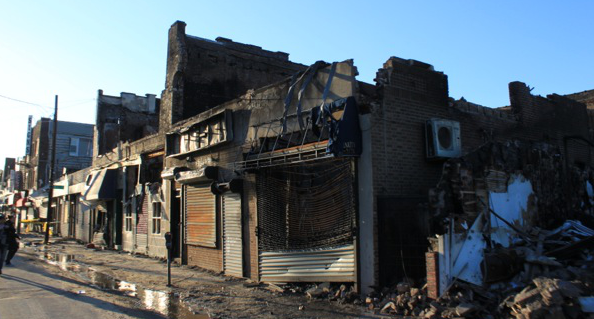[soundslides width=”620″ height =”533″ id=”3020″]
More than a week after power was restored to Lower Manhattan, a bus full of Queens residents made its way west to Rockaway. Most of them were apprehensive about what they would find once they reached their destination.
In the back of the bus, a young man named Sean Matthews shook his head nervously at a priest clutching a bible in his lap.
“Last week, cars were flipped over, everything was toppled, water all over the place, sand,” Matthews said. “I haven’t been back in a week. Maybe it’s better.”
In the front of the bus, an elderly man with wispy white hair and a well-worn jacket tried to lighten the mood, joking about how he was sick of his neighbors checking up on him. But, for the most part, the bus was somber as it moved further and further into damaged Rockaway, most of which still remains without power.
As a result of Hurricane Sandy, the Rockaway boardwalk has been ripped up and pushed north into the houses along the shore — or at least what remains of the houses. Most of those that line the beach have been destroyed. Roofs are caved in, facades torn off, foundations crumbled and some homes along the water blew away completely. Over 100 houses in the Breezy Point section of Rockaway burnt down, leaving nothing but charred rubble. They caught fire during the storm and were left to burn until floodwaters at the fire station receded enough for help to come.
In Rockaway, sand covers the streets, pushed inward by the floodwaters, piles of rubble and garbage line the sidewalks. American flags hang from broken rafters and bent street lights. A battered Halloween decoration was crushed between the sand being bulldozed back towards the beach. It is a similar scene in all of the worst hit areas: Coney Island, Red Hook, Staten Island, and Rockaway, the majority of which are all still lacking electricity and water.
“It was terrible. It was like a war zone. It was not the neighborhood I grew up in,” said Liza Hernandez, 27, a life-long resident of Coney Island. “It was so eerie. There was sand and debris everywhere. People were crying in the streets. My mom was crying because it broke her heart to see her community like that.”
“That’s not what Coney Island is supposed to be,” Hernandez added.
In areas without electricity, looting has become rampant, especially in the days immediately following the storm. One resident of Staten Island said he drove a few blocks to pick up a friend a few days after Sandy hit. In the short minutes she was inside the friend’s house, looters siphoned all the gas out of her car and broke into her home down the street. On the outside of a boarded up McDonald’s in Rockaway, the plywood has been spray-painted to ward off potential looters. In loopy scrawl it reads, “Trust me, save your energy. Somebody beat u here already.”
Amid the chaos and the seemingly endless work that remains to be done to restore these neighborhoods, a sense of community can still be found, especially in Rockaway.

“It’s families helping families,” said Frederick Radie, a resident of Queens who spends his weekends in the Rockaways.
While FEMA, The National Guard, the American Red Cross, and other prominent organizations all have a presence in the area, most of the workers helping in the Rockaways are either from small, independent volunteering organizations or are local residents. Occupy Sandy organizers, many of whom are affiliated with Occupy Wall Street, were among the first involved in the Rockaway recovery effort. Local businesses, such as Rockaway Taco, are providing access to household items, medicine, and other supplies.
Local churches such as Far Rockaway Community Church of the Nazarene have opened their doors to the community, hosting a constant stream of volunteers who distribute donations, legal advice, and food. Volunteers as well as members of the congregation spent their Sunday distributing food, cleaning supplies, and clothes, as well as supplying computers and telephones for powerless residents to use. One member of the church, Gwen Harry, 61, said she believes the Hurricane’s impact serves as a lesson to all those affected.
“Today in society people have grown materialistic. They focus on material things and lose
real meaning. One woman said that after 30 years, everything that she had ever worked for is in a bag,” Harry said. “One of the things that I learned from this is to take time to get to know people. Because material things disappear in the blink of an eye.”
Additional reporting by Nicolas Amara, Anoush Khatchatrian, Sophia Hoffenberg, Francia Sandoval, Cerise Steel, Charlotte Woods








I think other web site proprietors should take this web site as an model, very clean and great user genial style and design, as well as the content. You’re an expert in this topic!